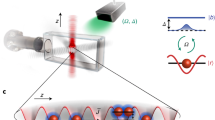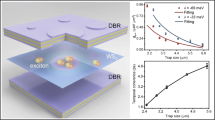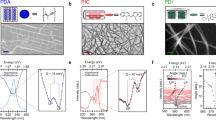Abstract
Conventional semiconductor laser emission relies on stimulated emission of photons1,2, which sets stringent requirements on the minimum amount of energy necessary for its operation3,4. In comparison, exciton–polaritons in strongly coupled quantum well microcavities5 can undergo stimulated scattering that promises more energy-efficient generation of coherent light by ‘polariton lasers’3,6. Polariton laser operation has been demonstrated in optically pumped semiconductor microcavities at temperatures up to room temperature7,8,9,10,11,12, and such lasers can outperform their weak-coupling counterparts in that they have a lower threshold density12,13. Even though polariton diodes have been realized14,15,16, electrically pumped polariton laser operation, which is essential for practical applications, has not been achieved until now. Here we present an electrically pumped polariton laser based on a microcavity containing multiple quantum wells. To prove polariton laser emission unambiguously, we apply a magnetic field and probe the hybrid light–matter nature of the polaritons. Our results represent an important step towards the practical implementation of polaritonic light sources and electrically injected condensates, and can be extended to room-temperature operation using wide-bandgap materials.
This is a preview of subscription content, access via your institution
Access options
Subscribe to this journal
Receive 51 print issues and online access
$199.00 per year
only $3.90 per issue
Buy this article
- Purchase on Springer Link
- Instant access to full article PDF
Prices may be subject to local taxes which are calculated during checkout





Similar content being viewed by others
References
Coldren, L. A. & Corzine, S. W. Diode Lasers and Photonic Integrated Circuits (Wiley, 1995)
Einstein, A. Strahlungs-emission und -absorption nach der Quantentheorie. Verh. Deutsch. Phys. Gesell. 18, 318–323 (1916)
Imamoğlu, A., Ram, R. J., Pau, S. & Yamamoto, Y. Nonequilibrium condensates and lasers without inversion: exciton-polariton lasers. Phys. Rev. A 53, 4250–4253 (1996)
Bernard, M. G. A. & Duraffourg, G. Laser conditions in semiconductors. Phys. Status Solidi B 1, 699–703 (1961)
Weisbuch, C., Nishioka, M., Ishikawa, A. & Arakawa, Y. Observation of the coupled exciton-photon mode splitting in a semiconductor quantum microcavity. Phys. Rev. Lett. 69, 3314–3317 (1992)
Kavokin, A. & Malpuech, G. Cavity Polaritons (Elsevier, 2003)
Deng, H. et al. Condensation of semiconductor microcavity exciton polaritons. Science 298, 199–202 (2002)
Kasprzak, J. et al. Bose–Einstein condensation of exciton polaritons. Nature 443, 409–414 (2006)
Balili, R. et al. Bose-Einstein condensation of microcavity polaritons in a trap. Science 316, 1007–1010 (2007)
Christopoulos, S. et al. Room-temperature polariton lasing in semiconductor microcavities. Phys. Rev. Lett. 98, 126405 (2007)
Sun, L. et al. Room temperature one-dimensional polariton condensate in a ZnO microwire. Preprint at http://arxiv.org/abs/1007.4686 (2010)
Deng, H., Weihs, G., Snoke, D., Bloch, J. & Yamamoto, Y. Polariton lasing vs. photon lasing in a semiconductor microcavity. Proc. Natl Acad. Sci. USA 100, 15318–15323 (2003)
Tsotsis, J. et al. Lasing threshold doubling at the crossover from strong to weak coupling regime in GaAs microcavity. N. J. Phys. 14, 023060 (2012)
Tsintzos, S. I. et al. A GaAs polariton light-emitting diode operating near room temperature. Nature 453, 372–375 (2008)
Bajoni, D. et al. Polariton light-emitting diode in a GaAs-based microcavity. Phys. Rev. B 77, 113303 (2008)
Khalifa, A. A., Love, A. P. D., Krizhanovskii, D. N., Skolnick, M. S. & Roberts, J. S. Electroluminescence emission from polariton states in GaAs-based semiconductor microcavities. Appl. Phys. Lett. 92, 061107 (2008)
Bajoni, D., Senellart, P., Lemaître, A. & Bloch, J. Photon lasing in GaAs microcavity: similarities with a polariton condensate. Phys. Rev. B 76, 201305 (2007)
Ohadi, H. et al. Spontaneous symmetry breaking in a polariton and photon laser. Phys. Rev. Lett. 109, 016404 (2012)
Kulakovskii, V. D. et al. Magnetic field control of polarized polariton condensates in rectangular microcavity pillars. Phys. Rev. B 85, 155322 (2012)
Wertz, E. et al. Spontaneous formation of a polariton condensate in a planar GaAs microcavity. Appl. Phys. Lett. 95, 051108 (2009)
Kulakovskii, V. D. et al. Bose-Einstein condensation of exciton polaritons in high-Q planar microcavities with GaAs quantum wells. JETP Lett. 92, 595–599 (2010)
Nelsen, B., Balili, R., Snoke, D. W., Pfeiffer, L. & West, K. Lasing and polariton condensation: two distinct transitions in GaAs microcavities with stress traps. J. Appl. Phys. 105, 122414 (2009)
Dang, L. S., Heger, D., Andre, R., Boeuf, F. & Romestain, R. Stimulated emission of polariton luminescence in semiconductor microcavity. Phys. Rev. Lett. 81, 3920–3923 (1998)
Kammann, E., Ohadi, H., Maragkou, M., Kavokin, A. V. & Lagoudakis, P. G. Crossover from photon to exciton-polariton lasing. N. J. Phys. 14, 105003 (2012)
Keeling, J., Eastham, P. R., Szymanska, M. H. & Littlewood, P. B. BCS-BEC crossover in a system of microcavity polaritons. Phys. Rev. B 72, 115320 (2005)
Byrnes, T., Horikiri, T., Ishida, N. & Yamamoto, Y. BCS wavefunction approach to the BEC-BCS crossover of exciton-polariton condensates. Phys. Rev. Lett. 105, 186402 (2010)
Kappei, L., Szczytko, J., Morier-Genoud, F. & Deveaud, B. Direct observation of the Mott transition in an optically excited semiconductor quantum well. Phys. Rev. Lett. 94, 147403 (2005)
Rahimi-Iman, A. et al. Zeeman splitting and diamagnetic shift of spatially confined quantum-well exciton polaritons in an external magnetic field. Phys. Rev. B 84, 165325 (2011)
Larionov, A. V. et al. Polarized nonequilibrium Bose-Einstein condensates of spinor exciton polaritons in a magnetic field. Phys. Rev. Lett. 105, 256401 (2010)
Rubo, Y. G., Kavokin, A. V. & Shelykh, I. A. Suppression of superfluidity of exciton-polaritons by magnetic field. Phys. Lett. A 358, 227–230 (2006)
Tassone, F. & Yamamoto, Y. Exciton-exciton scattering dynamics in a semiconductor microcavity and stimulated scattering into polaritons. Phys. Rev. B 59, 10830–10842 (1999)
Kotlyar, R., Reinecke, T. L., Bayer, M. & Forchel, A. Zeeman spin splittings in semiconductor nanostructures. Phys. Rev. B 63, 085310 (2001)
Acknowledgements
This work was supported by the State of Bavaria, the National Science Foundation and by JSPS through its FIRST programme. I.G.S. acknowledges support from the Eimskip foundation. I.A.S. acknowledges support from the ‘Center of excellence in polaritonics’, IRSES SPINMET and POLAPHEN projects. A.R.-I. acknowledges a German National Academic Foundation fellowship. The authors thank T. Sünner, I. Lederer and A. Schade for experimental and technical support.
Author information
Authors and Affiliations
Contributions
S.H. initiated the study and guided the work together with S.R., Y.Y. and A.F. C.S., M.L. and S.H. designed and grew the wafer and performed pre-characterization. A.W. and M.K. processed the devices. A.R.-I., J.F., N.Y.K., L.W. and S.R. established an electrical/optical Fourier-space spectroscopy setup. A.R.-I., J.F., M.A., C.S., S.H., N.Y.K. and S.R. performed experiments. A.R.-I., C.S. and M.A. analysed and interpreted the experimental data, supported by S.H., S.R., V.D.K., I.G.S. and I.A.S. C.S., A.R.-I. and S.H. wrote the manuscript, with input from all co-authors. C.S. and A.R.-I. contributed equally to the study.
Corresponding authors
Ethics declarations
Competing interests
The authors declare no competing financial interests.
Supplementary information
Supplementary Information
This file contains Supplementary Text and Data, Supplementary Figures 1-5 and Supplementary References. (PDF 560 kb)
Rights and permissions
About this article
Cite this article
Schneider, C., Rahimi-Iman, A., Kim, N. et al. An electrically pumped polariton laser. Nature 497, 348–352 (2013). https://doi.org/10.1038/nature12036
Received:
Accepted:
Published:
Issue Date:
DOI: https://doi.org/10.1038/nature12036
This article is cited by
-
Magneto-optical induced supermode switching in quantum fluids of light
Communications Physics (2023)
-
Plasmon mediated coherent population oscillations in molecular aggregates
Nature Communications (2023)
-
Single-particle properties of topological Wannier excitons in bismuth chalcogenide nanosheets
Scientific Reports (2023)
-
Deterministic and replaceable transfer of silver flakes for microcavities
Frontiers of Physics (2023)
-
Interacting plexcitons for designed ultrafast optical nonlinearity in a monolayer semiconductor
Light: Science & Applications (2022)
Comments
By submitting a comment you agree to abide by our Terms and Community Guidelines. If you find something abusive or that does not comply with our terms or guidelines please flag it as inappropriate.



